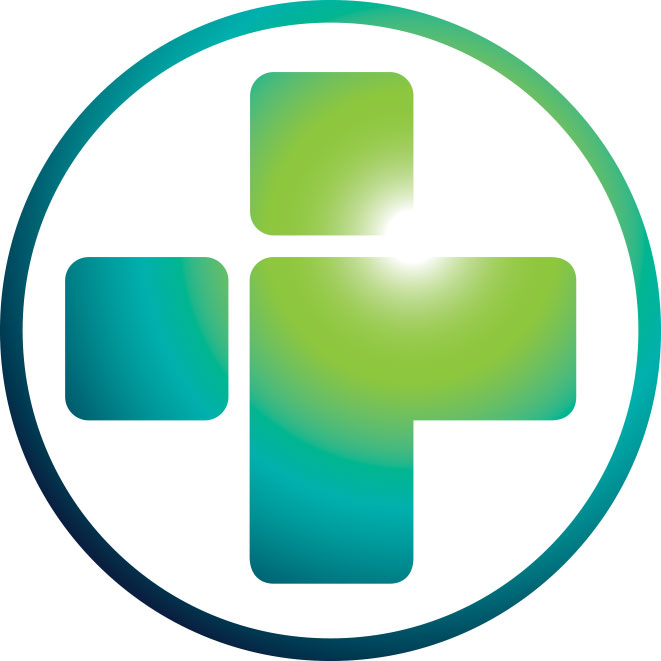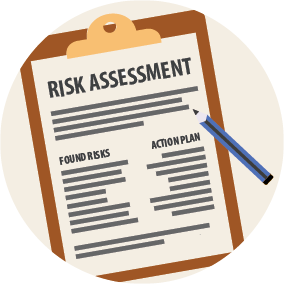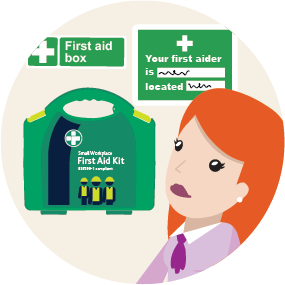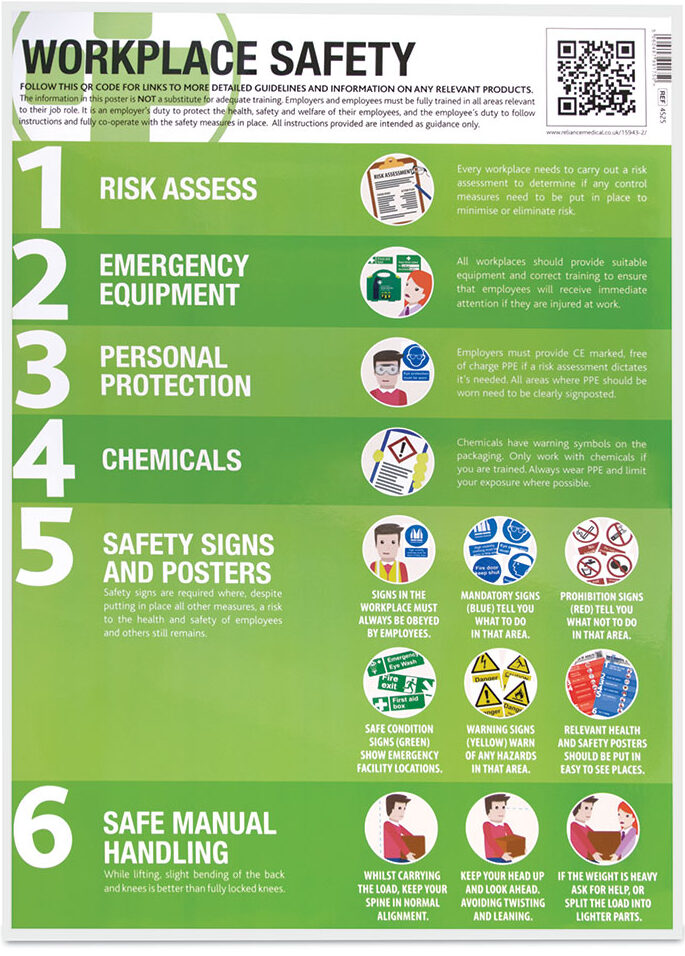Workplace Health & Safety
Additional material to support your information poster, with a quiz to test your knowledge.
1. Employers Responsibilities
The Health and Safety First Aid Regulations 1981 require you to provide adequate and appropriate first-aid equipment, facilities, and people so your employees can be given immediate help if they are injured or taken ill at work.
What precisely is ‘adequate and appropriate’ will depend on the circumstances in your workplace and you should assess what those first aid needs are. One of the most important aspects of your risk assessment is accurately identifying the potential hazards in your workplace.
The minimum first aid provision on any work site is:
• A suitably stocked first aid kit and other suitable first aid equipment
• An appointed person to take charge of first aid arrangements
• Information for employees about first aid arrangements
• An accident book for the recording of incidents
WHAT IS A “SUITABLY STOCKED” FIRST AID KIT?
The only official standard in the UK for First Aid Kit contents is the British Standard BS8599-1. This standard has effectively replaced the old HSE guidelines from 1997. New products and rapid changes in the workplace had gradually made the old HSE guidance less relevant and this prompted a thorough review and the introduction of the BS8599-1 standard.
WHAT CHANGES WERE MADE BETWEEN HSE AND BS8599-1?
BS8599-1 First Aid Kits include a much more comprehensive list of contents, including increased quantities of gloves, wipes, and plasters; and additional contents such as resuscitation shields, bandages, and burn dressings to ensure stronger measures are in place to deal with any accidents.
Additionally, BS8599-1 guidelines provide employers with an approach to first aid that includes their risk needs assessment and takes into account the number of their employees. This combined approach to risk allows a demonstration of full compliance with the legislation in place.
“BS8599-1 First Aid Kits are now the best guarantee for employers to demonstrate their commitment to meet their legal obligations”.
USE YOUR RISK ASSESSMENT FINDINGS TO DECIDE WHAT FIRST AID KIT YOU NEED.
Having identified the hazards in your workplace, you must then decide how likely it is that harm will occur, i.e. the level of risk and what to do about it. Risk is a part of everyday life and you are not expected to eliminate all risks. What you must do is make sure you know about the main risks and the things you need to do to manage them responsibly.
Once you have identified potential hazards and how they may occur, you need to introduce control measures that will reduce the risk of harm from them. Make a written record of your significant findings and implement “reasonably practical” solutions. Review your risk assessment regularly, and always after any significant change in the workplace.
Identify if your workplace is:
LOW RISK
(e.g. shops, offices, libraries etc.)
HIGH RISK
(e.g. light engineering and assembly work, food processing, warehousing, extensive work with dangerous machinery or sharp instruments, construction, chemical manufacture etc.)
Think about the number of employees that are on site. Use both the risk element and employee numbers to determine which size of BS8599-1 standard First Aid Kit you should purchase:
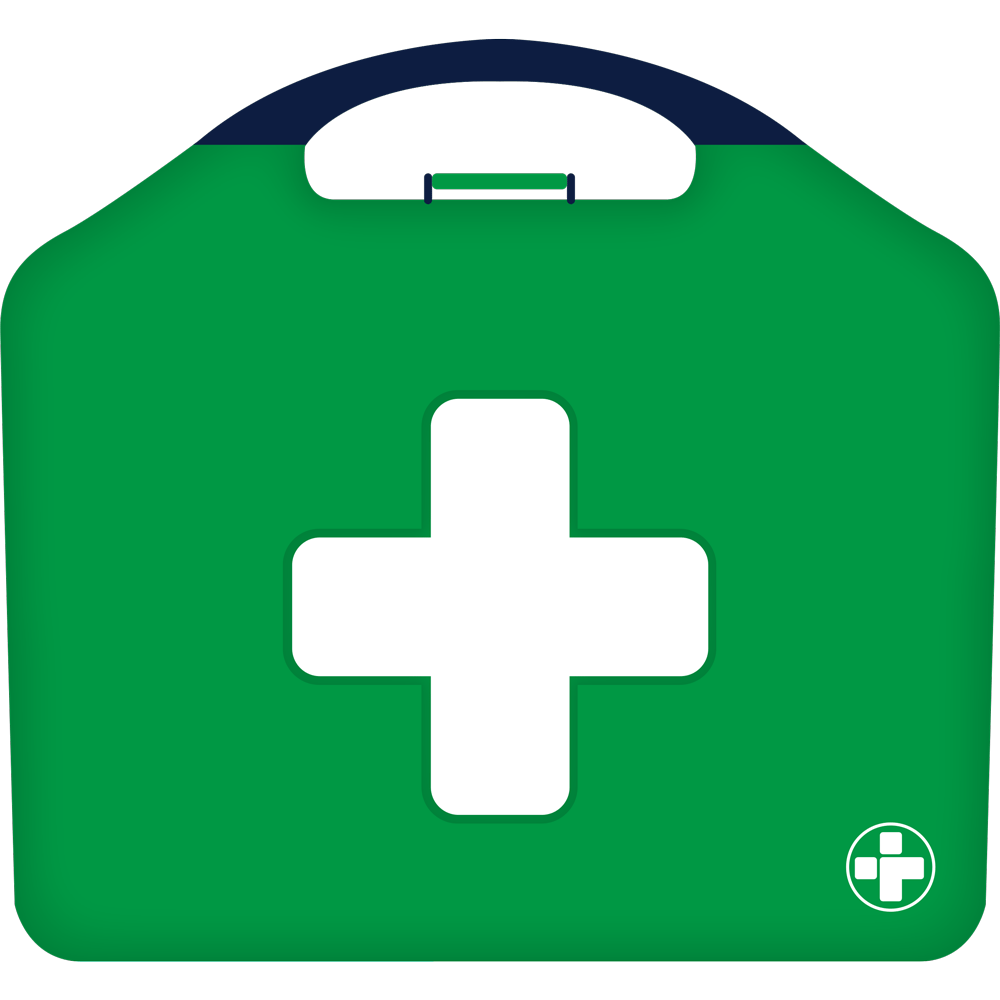
SMALL BS8599-1 KIT
GUIDELINES
LOW RISK: Less than 25 employees
HIGH RISK: Less than 5 employees

MEDIUM BS8599-1 KIT GUIDELINES
LOW RISK: 25-100 employees
HIGH RISK: 5-25 employees

LARGE BS8599-1 KIT
GUIDELINES
LOW RISK: 1 Kit per 100 employees HIGH RISK: 1 Kit per 25 employees
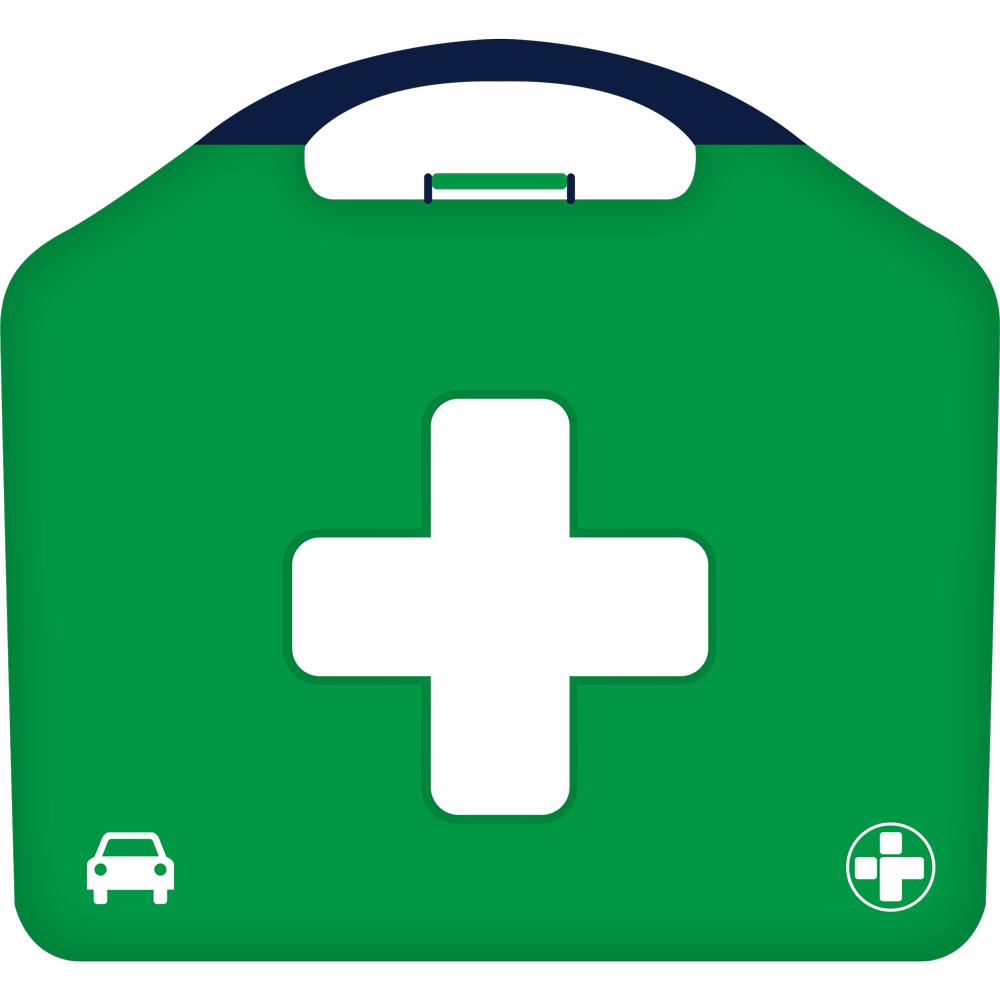
BS8599-1 TRAVEL KIT GUIDELINES
For use by 1 employee who works out of the workplace
2. Safety Signage in the Workplace
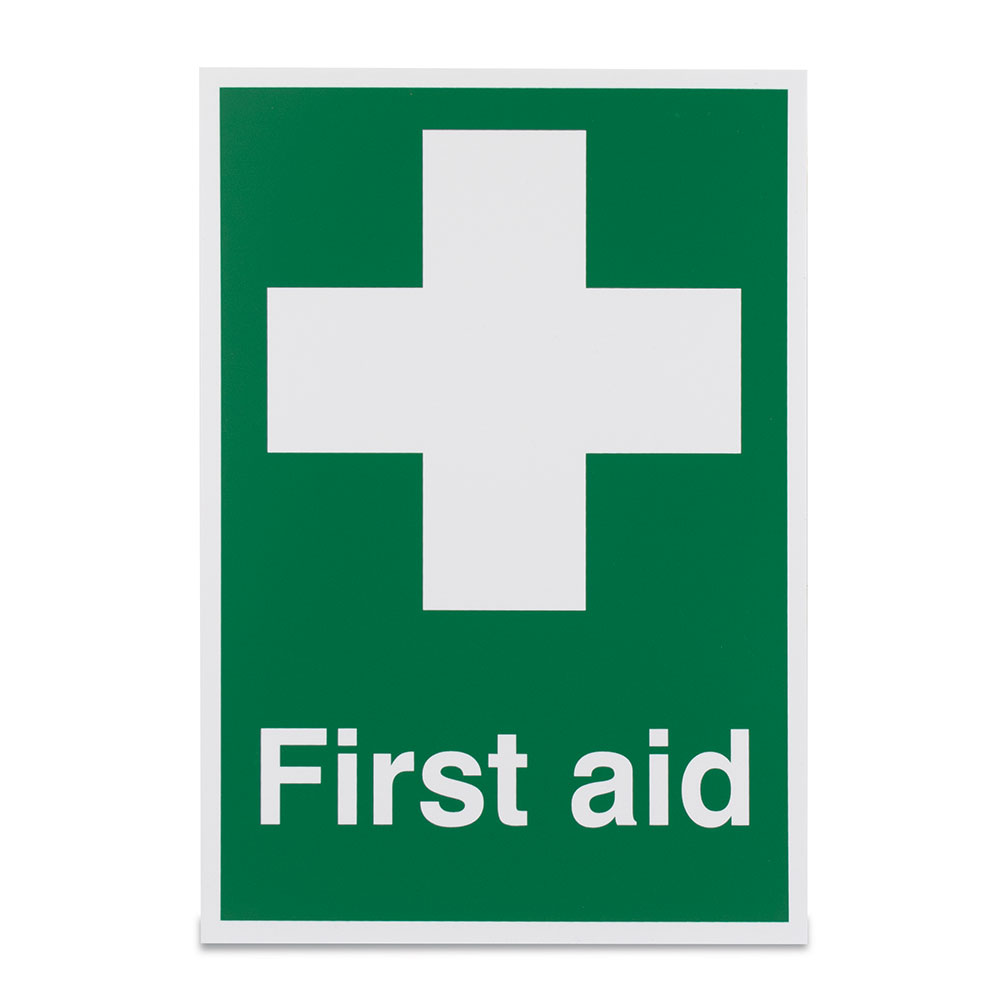
SAFE CONDITION SIGNS
Signs which are used to give employees information on emergency exits, first aid, and rescue facilities, e.g. Emergency Exit, Fire Exit, Eye Wash Station.
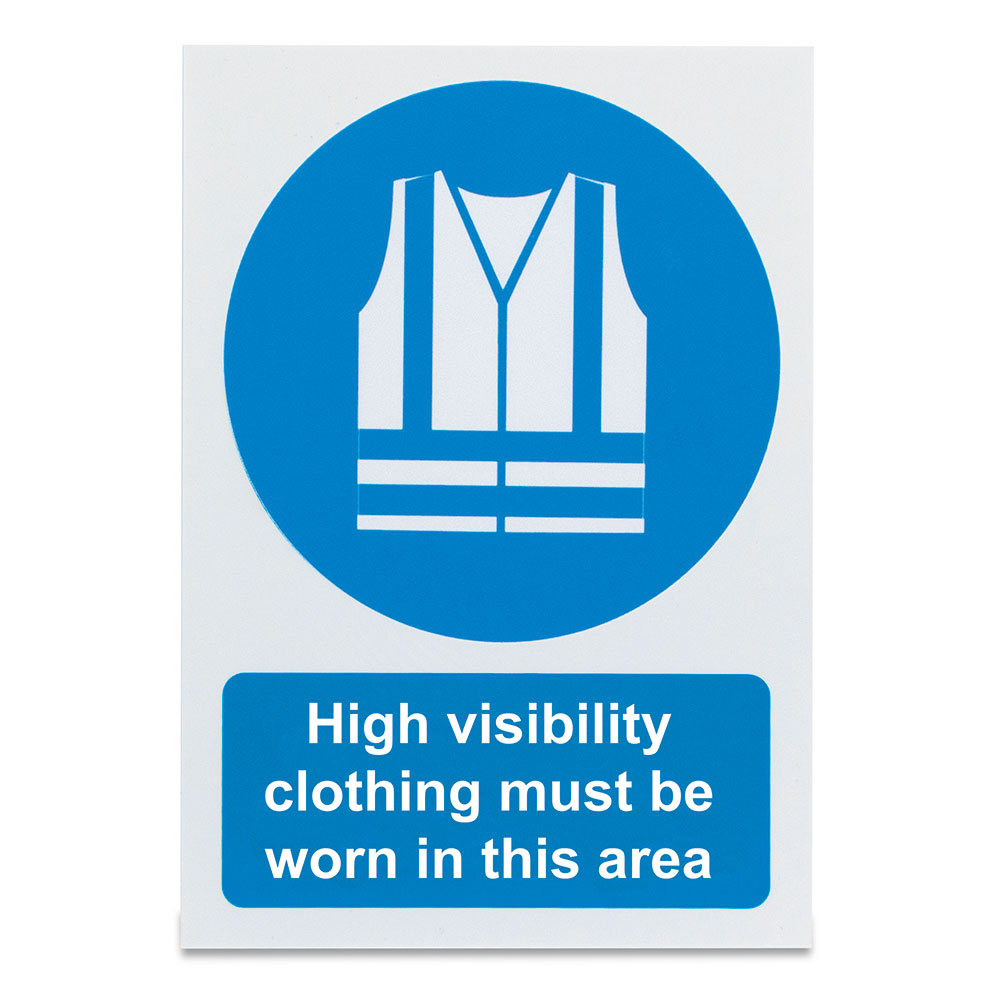
MANDATORY SIGNS
Signs which tell you that a specific instruction must be followed, e.g. ‘eye protection must be worn in this area’.
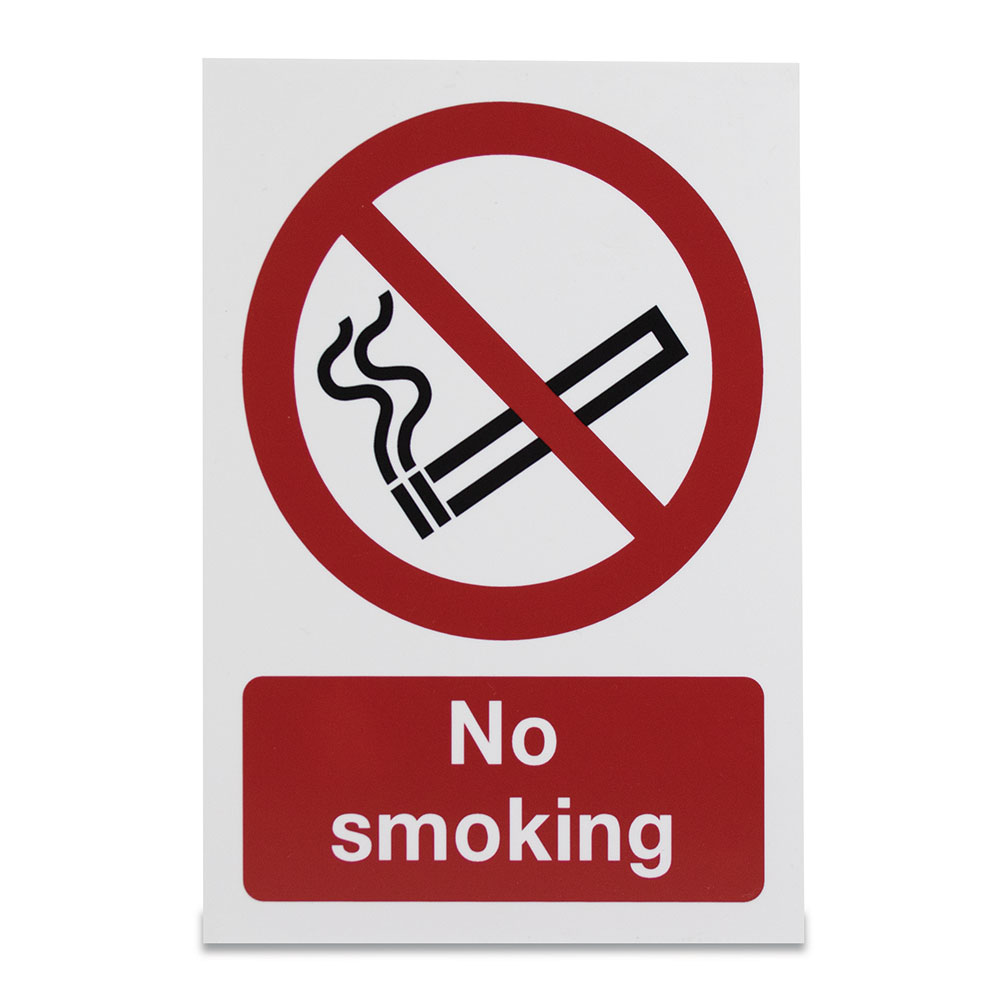
PROHIBITION SIGNS
Signs which tell you what you must NOT do. These are used to prohibit actions that are likely to increase or cause danger, e.g. ‘No Smoking’, ‘No Entry’.
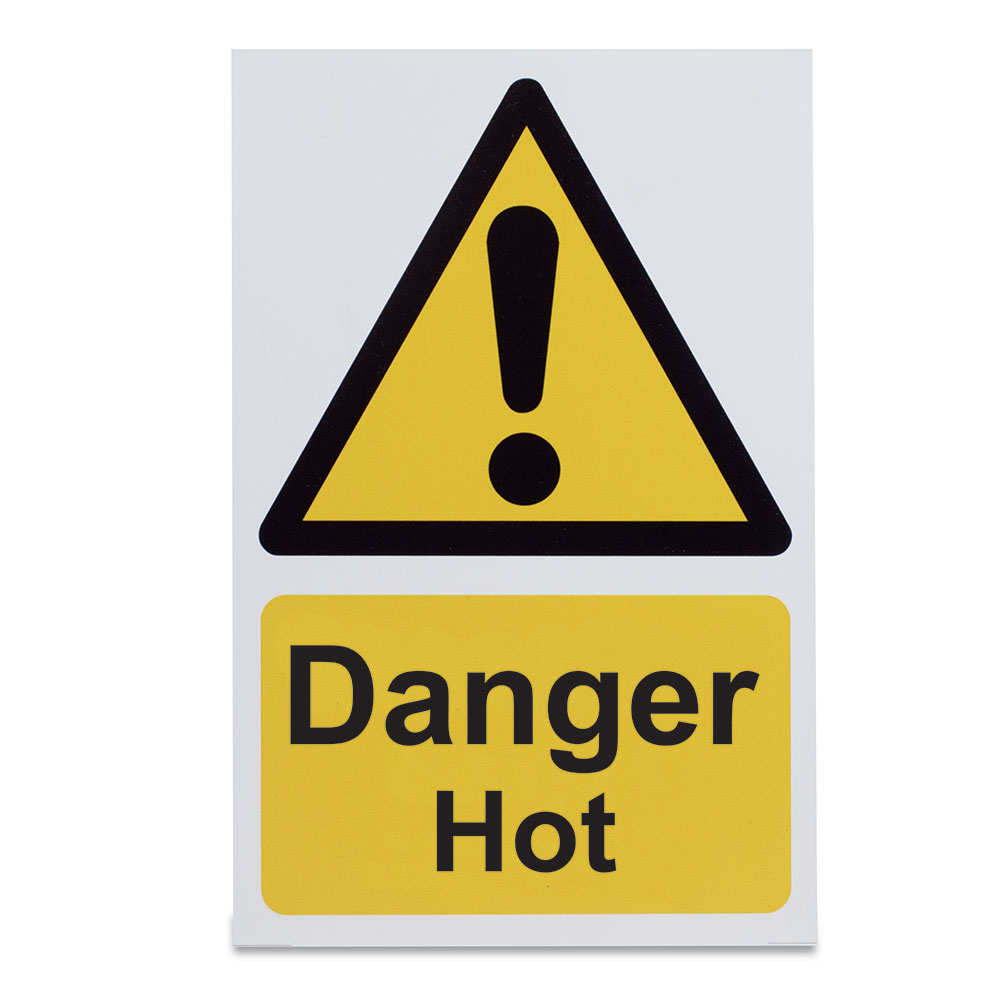
WARNING SIGNS
Signs which provide advance warning of a hazard or a danger, e.g. ‘Danger: Electricity’, ‘Danger: Slippery Surface’, ‘Caution: Hot’.
3. COSHH
CONTROL OF SUBSTANCEES THAT ARE HAZARDOUS TO HEALTH
COSHH is the law that requires employers to control substances that are hazardous to health. Most businesses employ processes that use substances which could cause harm to employees, contractors, and other people. Substances can take many forms and include, but are not limited to, chemicals, fumes, dust, vapours, and biological agents (germs). If packaging displays a hazard symbol, then the product is classed as a hazardous substance.
COSHH SYMBOLS AND THEIR MEANINGS
Hazard pictograms alert us to the presence of a hazardous chemical. The pictograms help us to know that the chemicals we are using might cause harm to people or the environment. One or more pictograms might appear on the labelling of a single chemical.
These products could be common substances in everyday use such as paint, bleach, solvent, or fillers. When a product is ‘dangerous for supply’,
by law, the supplier must provide you with a Safety Data Sheet. Data sheets should be stored in a safe place where employees can access them in the case of an emergency.
It is a good idea to memorise all common COSHH symbols:
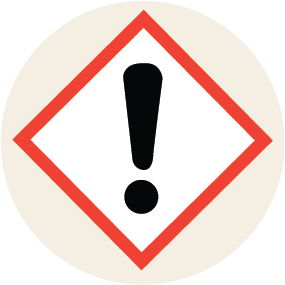
CAUTION:
HARMFUL OR IRRITANT
DEFINITION:
A substance that may cause inflammation and irritation when in contact with the skin. May also cause health risks if ingested, inhaled, or if penetration of the skin occurs.
HOW TO MINIMISE RISK:
• Avoid contact with the skin.
• Do not inhale.
• After handling substances, wash thoroughly before you eat or drink.
• Avoid any contact with eyes. If this occurs, wash thoroughly with water and seek immediate medical advice.
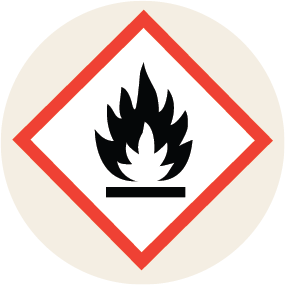
CAUTION:
FLAMMABLE
DEFINITION:
Chemicals that may catch fire in contact with air and only need brief contact with an ignition source, or, a substance that has a very low flash point or evolves into highly flammable gases in contact with water.
HOW TO MINIMISE RISK:
• Make sure that the chemical is stored in a cool, well-ventilated place.
• Ensure chemicals are stored with their lids tightly sealed. When using, do not breath in spray or vapour.
• Avoid contact with skin.
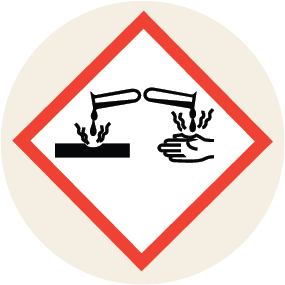
CAUTION:
CORROSIVE
DEFINITION:
A chemical substance that may destroy living tissue on contact.
HOW TO MINIMISE RISK:
• Always wear protective PPE clothing.
• Dispose of used contaminated clothing after use.
• Avoid contact with the skin. If this event occurs, rinse with plenty of water.
• Avoid contact with eyes. If this event occurs, rinse with plenty of water and seek immediate medical help.
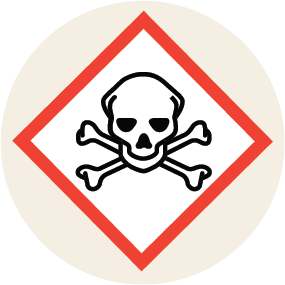
CAUTION:
TOXIC/VERY TOXIC
DEFINITION:
A substance that will cause severe health problems; potentially fatal if ingested or inhaled.
HOW TO MINIMISE RISK:
• Always wear PPE when handling.
• If substance comes into contact with skin, wash thoroughly with plenty of water.
• If substance comes into contact with eyes, wash thoroughly with water and seek immediate medical advice.
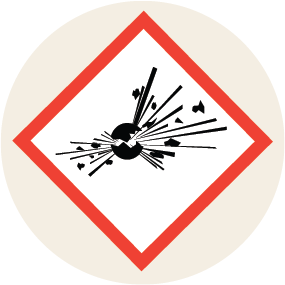
CAUTION:
EXPLOSIVE
DEFINITION:
A substance which may explode if it comes into contact with heat or flame.
HOW TO MINIMISE RISK:
• Before handling, ensure you have read and fully understood the instructions.
• Ensure that substances are stored in a cool and well-ventilated place.
• Store away from any sources of ignition or heat.
• Ensure substances are disposed of safely after use.
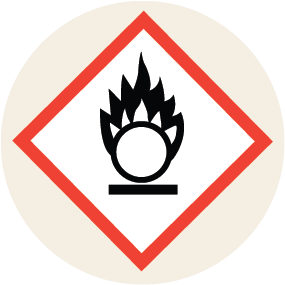
CAUTION:
OXIDISING
DEFINITION:
Chemicals and preparations that react exothermically with other chemicals and may intensify fires.
HOW TO MINIMISE RISK:
• Before handling, ensure you have read and fully understood the instructions.
• Make sure that the chemical is stored in a cool, well-ventilated place.
• Store away from any sources of ignition or heat.
• Ensure substances are disposed of safely after use.
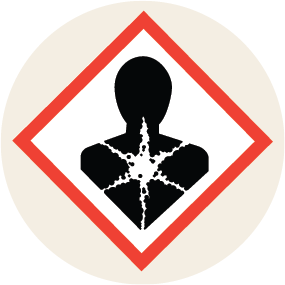
CAUTION:
RESPIRATORY SENSITISER
DEFINITION:
The substance is a respiratory sensitiser, and may cause allergy or asthma symptoms or breathing difficulties if inhaled.
HOW TO MINIMISE RISK:
• If substitution is not possible, minimise the exposure concentration, time, frequency, and number of workers exposed.
• Work in a well-ventilated area.
• Ensure chemicals are stored with their lids tightly sealed.
• Ensure substances are disposed of safely after use.
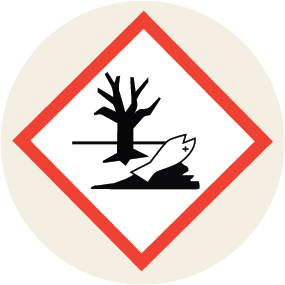
CAUTION:
HAZARDOUS TO THE ENVIRONMENT
DEFINITION:
A substance that may present a danger to one or more parts of the environment.
HOW TO MINIMISE RISK:
• When disposing of the substance, ensure that the chemical and the container are disposed of safely.
All information based on the Health and Safety Executive’s ‘Working with Substances Hazardous to Health’ and ‘Identifying Hazards and Assessing Risks.’
4. Safe Manual Handling Techniques


A. CONSIDER THE TASK AND THE LOAD
BEFORE YOU BEGIN THE LIFT
Plan the lift, consider the task:
Can a lifting aid be used?
Can someone help you lift it?
Can you reduce the amount of twisting or stooping?
Can you push, rather than pull?
Will help be needed with the load?
Consider the load:
Can the load be made lighter?
Is the load an awkward shape?
Can the load be made easier to grasp?
Consider the environment:
Have you fully planned the route you are taking?
Are there any doors that need to be opened for you?
Are there any obstructions or slippery floors?
Have you planned for needed rest stops?
Are there any variations in the floor level?
Are the lighting conditions acceptable?
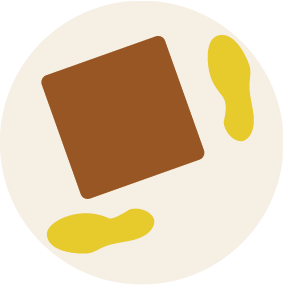
B. ADOPT A STABLE POSITION
Your feet should be apart, with one leg placed slightly forward to maintain balance (alongside the load, if it is on the ground). You should be prepared to move your feet during the lift to maintain stability. Ensure that you are wearing suitable footwear and clothing.

C. GET A GOOD HOLD ON THE OBJECT
Get a good grip on the object and use handles if it has them. Where possible, the load should be hugged as close to the body as possible; this may be better than gripping it tightly with your hands only. Keep in mind that the load can slip if you are not holding it properly.
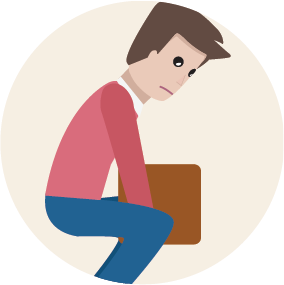
D. START WITH A GOOD POSTURE
Keeping your shoulders straight, bend your knees, with your spine and knees in normal alignment. At the start of the lift, slight bending of the back, hips, and knees is preferable to fully flexing the back (stooping), or fully flexing the hips and knees (squatting).
E. LIFT THE LOAD – AVOID TWISTING OR LEANING SIDEWAYS
When you are lifting the load, avoid twisting and leaning, especially if your back is bent. Shoulders should be kept level and facing in the same direction as the hips. Turning by moving your feet is better than twisting and lifting at the same time. This can happen if the legs begin to straighten before starting to raise the load. If a close approach to the load is not possible, try to slide it towards your body before attempting to lift it.
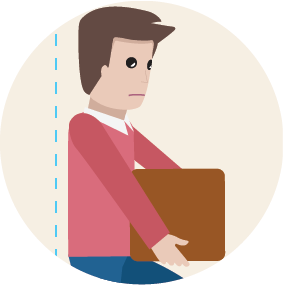
F. KEEP THE LOAD AS CLOSE AS POSSIBLE TO THE WAIST
Keep the load close to the body for as long as possible while carrying. The heaviest side of the load should be held closest to the body.
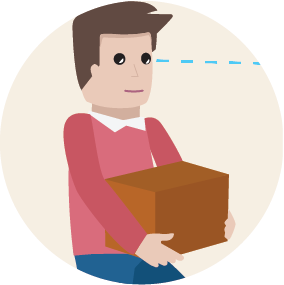
H. WHILE YOU ARE CARRYING THE LOAD, LOOK STRAIGHT AHEAD AND MOVE SMOOTHLY
Once the load is securely held, do NOT look down but keep looking ahead. The load should not be jerked or snatched as this can make it harder to keep control and can increase the risk of injury.
NEVER LIFT MORE THAN YOU CAN SAFELY MANAGE!
Information based on the Health and Safety Executive’s
‘First Aid at Work,
Working with Substances Hazardous to Health’ and
‘Manual Handling Guide’
Workplace Safety Quiz
A short quiz to test your knowledge of Workplace Safety.
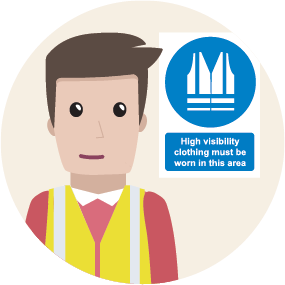
All information is for guidance only and correct at time of publication.

